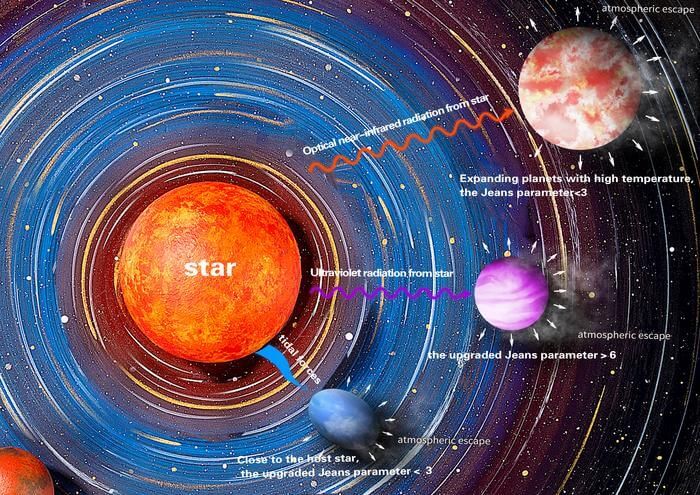A scientist has learned more about the violent processes that rip atmospheres away from planets, finding that squashing and squeezing by a parent star can contribute to this process.
The research, conducted by Guo Jianheng from the Yunnan Observatories of the Chinese Academy of Sciences, could help astronomers better determine which extrasolar planets, or “exoplanets,” to look at more closely as they expand their search for life beyond the solar system.
There are multiple ways planets can lose their atmospheres to space, including the upper atmosphere leaving the planet as a whole, called ” hydrodynamic escape.” This process is thought to be more extreme than the process by which our solar system’s planets leak particles into space today, through “hydrodynamic escape,” which causes a planet to lose mass while also impacting its climate and, thus, its habitability.
Jianheng simulated atmosphere loss from low-mass exoplanets. In particular, Jianheng focused on the hydrodynamic escape atmosphere-loss mechanism and suggested a new classification method that can be used to understand this, and other, escape processes.
Related: Possibly habitable Trappist-1 exoplanet caught destroying its own atmosphere
Though it no longer occurs for the inner planets around the sun, in the early era of the solar system, hydrodynamic atmospheric escape may have actually occurred to planets like Venus and Earth. Had the process continued, our planet may have been left with only a thin, mostly waterless atmosphere similar to what we see around our planetary neighbor, Mars.
That means understanding hydrodynamic atmospheric escape may help determine why Earth is capable of supporting life, but Mars and Venus aren’t.
Though hydrodynamic atmospheric escape isn’t currently ripping away atmospheres in the solar system, astronomers have used space- and ground-based telescopes to determine that these processes are indeed occurring around exoplanets located close to their host stars.
Smaller planets have a weight loss advantage
Jianheng performed computer simulations of low-mass exoplanets, which revealed that those with hydrogen-rich atmospheres could be experiencing hydrodynamic atmospheric escape as a result of their internal energy processes.
This energy manifests as internal heat and is generated by the tidal forces that squash and squeeze the planet — forces caused by the gravity of their parent stars and by the bombardment of intense ultraviolet radiation from those stars. Sometimes, these forces can even deform planets to ovoid shapes.
Previously, modeling has been employed to understand the physical mechanisms driving hydrodynamic escape, but these models have been complex and often resulted in obscure conclusions.
Jianheng, on the other hand, posits that the physical parameters needed to classify the mechanisms behind hydrodynamic escape are simple. You just have to think about the characteristics of the planets and stars involved, the researcher says, such as their masses, radii, and the orbital separation between the planet and its star.

The simulations conducted by Jianheng revealed that for more “puffy” and less dense exoplanets, those with low masses and large radii, high enough internal temperatures could cause atmospheric escape. A ratio of a planet’s internal energy to its gravitational potential energy, known as the “Jeans parameter,” could be used to determine if a planet would experience atmosphere escape. The smaller the Jeans parameter is, the more likely atmospheric escape is to occur.
For planets that can’t experience hydrodynamic escape due to high internal energy, Jianheng found that a modified Jeans parameter accounting for tidal forces generated by stars could determine and distinguish the roles these forces and extreme ultraviolet radiation play in driving atmospheric escape.
The simulation also revealed that low-mass planets with high gravitational potential arising from an increased distance between a planet and its star, as well as the lower radiation such a world would be bombarded with, results in a slower hydrodynamic atmospheric escape.
The findings could help scientists better determine how low-mass planets’ atmospheres change over time, helping to paint a better picture of the habitability of these worlds.
This research was published on May 9 in the journal Nature Astronomy.